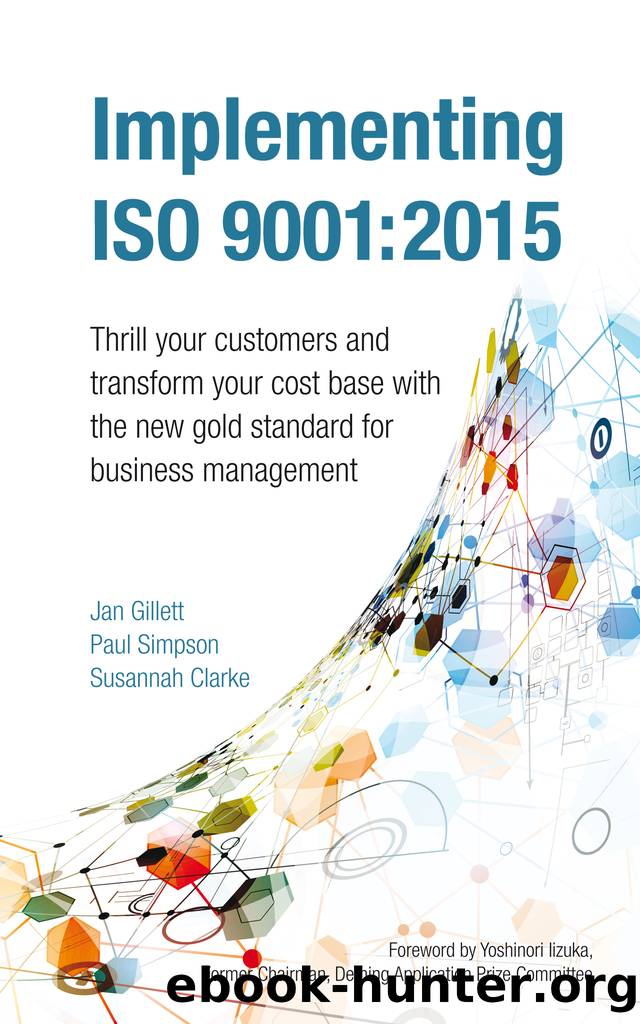Implementing ISO 9001 by Jan Gillett

Author:Jan Gillett
Language: eng
Format: epub
Publisher: Infinite Ideas Ltd
Published: 2015-11-23T10:50:27+00:00
Implementing standardisation across multiple processes
Meetings are always about increasing readiness to change
The implementation team must contain the line managers and supervisors of the area affected by the changes. This should not be fudged, no matter how much they may claim they havenât got time for meetings. At this stage, if the work is within your own department, you can insist on this. Anyone who suggests they send a deputy for a meeting that is to plan changes in their function is indicating that they donât think it is important. Their staff will take the lead from the boss, and will quickly interpret any tendency to downplay any priorities.
Meeting management processes should be exemplary (again, are you surprised?). As with the exploration, problem solving and review stages, the meetings are the one component that you can definitively lead and ensure they are conducted as you wish. All of the guidelines outlined in Chapter 2 remain valid, with a particular emphasis on time management, as many of the delegates will necessarily be called off their regular jobs, and will not appreciate being delayed. You are likely to find this meeting discipline tested. Some line managers have so far been able to observe your investigation and planning work from a distance, and hope that if they keep their head down it will all go away. As they find themselves pinned down, asked for commitments or even asked to behave differently, they will come up with many ways to prevaricate. Hopefully your problem-solving team contained attendees from the areas being affected by the changes, and they will be ambassadors for the solutions, but that cannot always be the case.
Each meeting will therefore need to contain elements of increasing readiness to change. The emphasis will depend upon attendeesâ previous exposure. In the first place you must build their awareness of the degree of dissatisfaction about the current situation: you cannot assume they have accepted or even heard of the previous work you have done.
Next is to clarify with them the goals that were developed in the review stage of the problem-solving work, and to refine them with this audience who are closest to the routine work ahead.
The third component is to build the change process with them; the precise steps that are intended to ensure that the new ways of working have the best possible chance of being reliably and quickly adopted.
Download
This site does not store any files on its server. We only index and link to content provided by other sites. Please contact the content providers to delete copyright contents if any and email us, we'll remove relevant links or contents immediately.
Whiskies Galore by Ian Buxton(41937)
Introduction to Aircraft Design (Cambridge Aerospace Series) by John P. Fielding(33092)
Small Unmanned Fixed-wing Aircraft Design by Andrew J. Keane Andras Sobester James P. Scanlan & András Sóbester & James P. Scanlan(32763)
Craft Beer for the Homebrewer by Michael Agnew(18196)
Turbulence by E. J. Noyes(7977)
The Complete Stick Figure Physics Tutorials by Allen Sarah(7336)
Kaplan MCAT General Chemistry Review by Kaplan(6899)
The Thirst by Nesbo Jo(6877)
Bad Blood by John Carreyrou(6581)
Modelling of Convective Heat and Mass Transfer in Rotating Flows by Igor V. Shevchuk(6406)
Learning SQL by Alan Beaulieu(6237)
Weapons of Math Destruction by Cathy O'Neil(6214)
Man-made Catastrophes and Risk Information Concealment by Dmitry Chernov & Didier Sornette(5956)
Digital Minimalism by Cal Newport;(5704)
Life 3.0: Being Human in the Age of Artificial Intelligence by Tegmark Max(5512)
iGen by Jean M. Twenge(5384)
Secrets of Antigravity Propulsion: Tesla, UFOs, and Classified Aerospace Technology by Ph.D. Paul A. Laviolette(5332)
Design of Trajectory Optimization Approach for Space Maneuver Vehicle Skip Entry Problems by Runqi Chai & Al Savvaris & Antonios Tsourdos & Senchun Chai(5037)
Pale Blue Dot by Carl Sagan(4953)
